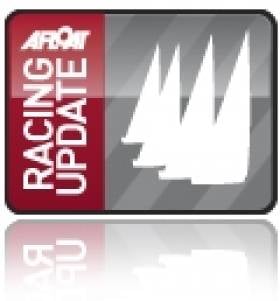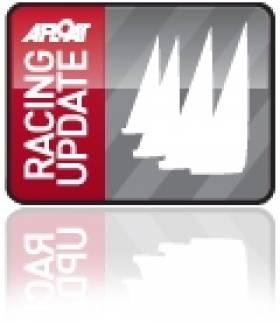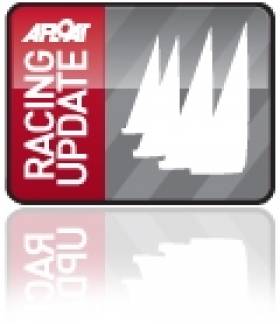Displaying items by tag: ISORA
Lively Lady Sails to Victory in Fickle ISORA Race to Rockabill
The course was from the start to round Rockabill to starboard and back to the finish at the mouth of Dun Laoghaire Harbour – 38 miles. The length of the original course to the M2 was 54 miles. To make the race more tactical, Ireland's Eye and Lambay were not marks on the course.
The start was provided by Larry Power of the NYC at the DBSC Pier mark. The wind at that time was south west and was gusting up to 25knots. This sent the fleet, most with spinnakers, charging towards the Bailey. It was not long before the wind decreased to 10-12 knots and veered to west.
"Tsunami" led the charge off the line but it was not long before "Lively Lady" took up poll position which she held for the remainder of the race. The fleet split as it approached Lambay. Those boats that chose to go inside the island went onto white sails while the boats that stayed outside could hold their spinnakers. There did not appear to be an advantage to either side of the island.
The fleet stayed well bunched at it approach Rockabill with "Lively Lady" rounding first followed by "English Mick" and "Jedi". On the return leg the wind decreased further to 8-10 knots from the west. Again the decision was whether to hold the spinnaker for the tight reach and what side of Lambay to go. "Lively Lady" who was leading the fleet again went inside while most of the fleet remained outside the island. This time however, there appeared to be an advantage as "Lively Lady" pulled further in front.
Passing Howth Head and approaching the finish, the wind got even more fickle. As the lead boats entered Dublin Bay the wind backed the south west giving abeat to the finish. However, there was no stopping "Lively Lady" who took line honours and first in Class 1 and Overall. "Tsunami" took 2nd place in Class 1 while "African Challenge" took 3rd in Class 1. "Jedi" took 1st place in Class 2 and 2nd Overall. "Adelie" took 1st in Class 3 and 3rd overall.
The finish was provided by Martin Lawless on the NYC.
The next race is on the 10th September, the "James Eadie Race" from Pwllheli to Howth.
Racing Round Up - Weekend Irish Sailing Review
Lula Belle Wins ISORA Night Race
Lyver Race Report - Holyhead to Howth
Following very closely after the Dingle Race, ICRA Nationals in Crosshaven and the Sovereign's Cup in Kinsale, it was understandable that the numbers of ISORA boats taking part in the Lyver Race was small. The "grim" forecast of no wind did not encourage any boats to take part either. Never the less, five ISORA boats joined the 10 other boats and came to the start shortly after 19.00 on Friday the 1st July.
In view of the forecast the Sailing Committee shortened the race to the minimum requirements of RORC to qualify for the Fastnet Race – 75 miles. The time limit for the race was 24 hours after the start. With little wind at the start, and a north going tide just starting, they chose a "waypoint" just south of the Isle of Man as the turning mark and then to Howth.
This decision turned out to be inspired. The little wind there was there at the start was from the north-west so the first leg was a beat to the waypoint. Those boats who took the north leg from the start shot away in the tide while the others appeared to remain static in
Holyhead Bay. The forecast was for the wind to veer around to the south later. All through the night the winds were very fickle and boats had the chase constantly fluctuating breezes. Despite the little wind, it held for most of the night. At day break the wind started to pick up from the forecasted South and boats popped their kites and headed for the waypoint. There was a great gathering of boats at the waypoint with 12 boats visible around the waypoint.
The next leg to Howth was a white sail reach. This turned out to be an intensive chase with the J111 "Arabella" taking the lead followed by two Prima 38's, Stephen Tudor's "Sgrech" and Matt Davis's " Raging Bull". The wind from the south increased in strength as the fleet approached Howth.
While "Arabella" took line honours, it only managed to take 2nd place overall. "Sgrech" took 1st place and "Raging Bull" took 3rd place. All the boats that had not retired, managed to complete the course within the time limit.
The boats taking part in the race were fitted with trackers. The progress of the race can be followed by clicking the following link: http://live.adventuretracking.com/lyver2011
The prize-giving took place in Howth Yacht Club on Saturday evening.
Royal Cork's Anthony O'Leary is racing at the Scottish Series and better weather is promised tomorrow. ICRA has arranged craneage for next month's national championships and there are less than two weeks to the first gun of the Fireball World Championships in Sligo. 58 are entrered from nine countries.
All this and much more in Monday's Afloat ebulletin. Direct to your inbox Sign up here for free. Follow us on Facebook and Twitter too!
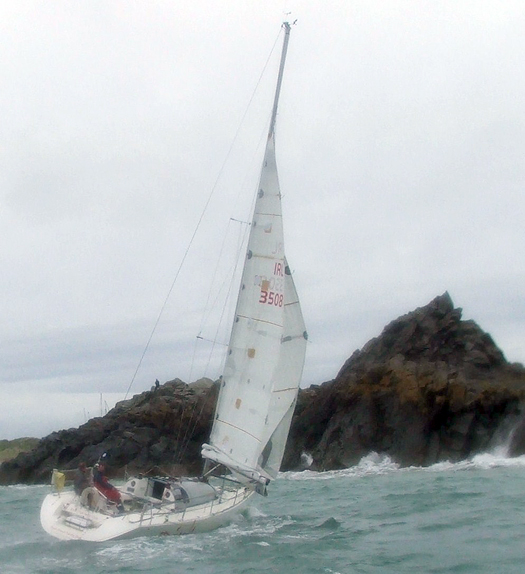
Barry Hurley and Mick Liddy prepare for the ISORA start in Wales on Saturday. More photos by Cathy Mullan on our ISORA post here
Raging Bull Charges Back to Top of ISORA Fleet
After missing the last ISORA race the 2010 Champion Raging Bull charged back to the front of yesterday's 7-boat fleet in a blustery offshore race across the Irish Sea from Pwlhelli in Wales to Wicklow harbour on the Irish East coast. Second to Matt Davis's Sigma 400 was the Welsh J109 Sgrech and third the Royal Irish A35 entry Aztec III skippered by Peter Beamish.
The bad weather before the race and difficulties with delivery as well as a general poor forecast (and a rugby match) for the race was the
main reasons for a very disappointing turn out for what is normally a very popular race.
Some of the fleet – now moored in Wicklow harbour – are sailing in this morning's Round the Turbines race from nearby Arklow Sailing Club. Provisional ISORA results from the Pwllheli to Wicklow race are below.
ISORA interests now turn to the big offshore fixture of the season, the Dun Laoghaire to Dingle Race on Saturday, June 11th.
Scroll down for Race start pics by Cathy Mullan| Boat Name | Sail No. | Type | IRC Rating | IRC | Finish Time | Time elapsed | Time elapsed | Corrected | Corrected | Place | Place |
|---|---|---|---|---|---|---|---|---|---|---|---|
| (provisional) | No Spinnaker | Time | Time | Class | O/A | ||||||
| English Mick | GBR4771R | Beneteau 47.7 | 1.127 | IRC | 18:43:20 | 37700 | 10:28:20 | 42487 | 11:48:07 | 2 | 7 |
| Quite Correct | IRL 5405 | DS54 | 1.095 | IRC | DNS | - | - | - | - | - | - |
| African Challenge | IRL 2649 | Fast 42 | 1.077 | IRC | DNS | - | - | - | - | - | - |
| Tsunami | IRL 4007 | First 40.7 | 1.061 | IRC | 18:54:19 | 38359 | 10:39:19 | 40698 | 11:18:18 | 1 | 5 |
| Lancastrian | GBR 7682T | Starlight 14.5m | 1.059 | IRC | DNS | - | - | - | - | - | - |
| Rebellion | IRL 6001 | Nicholson 58 | 1.054 | IRC | DNS | - | - | - | - | - | - |
| Orna | IRL 532 | 1.042 | IRC | DNS | - | - | - | - | - | - | |
| Aztec 3 | IRL29832 | A35 | 1.034 | IRC | 18:59:14 | 38654 | 10:44:14 | 39968 | 11:06:08 | 3 | 3 |
| Jedi | IRL 8088 | J109 | 1.029 | IRC | 19:04:01 | 38941 | 10:49:01 | 40070 | 11:07:50 | 4 | 4 |
| Raging Bull | IRL 9666 | Sigma 400 | 1.027 | IRC | 18:57:47 | 38567 | 10:42:47 | 39608 | 11:00:08 | 1 | 1 |
| Miss Scarlett | IRL 4763 | Sunfast 40.3 | 1.025 | IRC | DNS | - | - | - | - | - | - |
| Sgrech | GBR9319R | J109 | 1.021 | IRC | 19:03:00 | 38880 | 10:48:00 | 39696 | 11:01:36 | 2 | 2 |
| Lula Belle | IRL 3607 | First 36.7 | 1.019 | IRC | 19:51:46 | 41806 | 11:36:46 | 42600 | 11:50:00 | 5 | 8 |
| First of September | IRL 8581 | First 43.5 | 1.016 | IRC | 20:47:59 | 45179 | 12:32:59 | 45901 | 12:45:01 | 7 | 12 |
| Dinah | IRL 3508 | JOD 35 | 1.016 | IRC | 20:04:31 | 42571 | 11:49:31 | 43252 | 12:00:52 | 6 | 9 |
| Windshift | IRL 37737 | SF37 | 0.992 | IRC | DNS | - | - | - | - | - | - |
| Adelie | FRA 9631 | First 34.7 | 0.988 | IRC | 20:52:02 | 45422 | 12:37:02 | 44876 | 12:27:56 | 2 | 10 |
| Mojito | GBR 1536L | Bravaria 39 | 0.988 | IRC | 19:52:14 | 41834 | 11:37:14 | 41331 | 11:28:51 | 1 | 6 |
| Mistral of St Helier | K 8337 | Sigma 38 | 0.984 | IRC | 21:08:39 | 46419 | 12:53:39 | 45676 | 12:41:16 | 3 | 11 |
| Yahtzee | IRL 1068 | Oceanis 411 | 0.983 | IRC | 21:35:25 | 48025 | 13:20:25 | 47208 | 13:06:48 | 4 | 13 |
| Sarnia | IRL 2260 | 0.891 | IRC | DNS | - | - | - | - | - | - |
Racing Update: Third in Melges Pre-worlds, SB3 Worlds, Gung Ho top on Dublin Bay, ISORA, Foynes to Fenit
In other offshore sailing, defending champion Brian O'Donnell, on Whyte Dolphin is expected to defend his Gold Leaf trophy on a race from Foynes to Fenit.
Big Turnout Urged for Turbine Race
Offshore boss Peter Ryan is urging as many boats as possible to get invovled in the next ISORA race on May 28th from Pwllheli to Wicklow but also to make it a great offshore weekend by participating too in the Turbine Race from Arklow on the Sunday. It is the last ISORA race before the Dun Laoghaire to Dingle Race on June 11.
It is hoped that boats will remain in Wicklow after the ISORA race for the evening and head down to Arklow (14 miles) the following morning for the start of the Turbine Race.
Xpletive Wins ISORA's Pwllheli Day Race
An 11 mile beat to Gwylan Islands was a challenging part of ISORA's race three – the Pwllheli Day Race – and the crew on the J109 Sgrech made the best of the upwind leg getting to the Islands well ahead of the rest of the fleet.
The race was a fantastic advert for offshore racing with something for everyone and a little of everything.The forecast was for a 4 to 5 NW with WNW later and the scenic, triangular 40 mile course was set with a start from the CHPSC bridge and a short close reach to PSC 2. We then had a long (11miles) white sail reach to the Causeway cardinal buoy. The fleet at this point was bunched together with Xpletive slightly ahead but Mojito and Wennol III looking good.
The 11 mile beat to Gwylan Islands was challenging and the crew on Sgrech making the best of the upwind leg getting to the Islands well ahead of the fleet.
Then the start of the downwind spinnaker leg with what was billed as an exciting 15 miles of fast and furious not going to plan. A squall came through at Cilan Headland and caught Sgrech with her spinnaker up on the outside track. This squall brought a new head wind and allowed white sailed Xpletive to take an inside track to take the lead.
Early problems with Mojito's spinnaker allowed Wennol III through to third place at Cilan. Wennol III spotted the squall and wisely doused her spinnaker early and closed up on the leaders.
The wind backed and allowed a close reach for the finish with Expletive taking line honours closely followed by Sgrech with her a-sail closing the gap.
New to ISORA, Nanuaq, a Moody 38s thoroughly enjoyed the racing and they are now looking forward to the Pwllheli to Wicklow race on Saturday 28th May (and the party in Wicklow after racing).
| Rank | Fleet | Boat | SailNo | Type | Rating | Start | Finish | Elapsed | Corrected | Points |
|---|---|---|---|---|---|---|---|---|---|---|
| 1 | Class 1 | Xpletive | 4242 | X Yachts | 1.027 | 10.35.00 | 16.25.55 | 5.50.55 | 6.00.23 | 92.7 |
| 2 | Class 2 | Sgrech | GBR9319R | J109 | 1.026 | 10.35.00 | 16.27.03 | 5.52.03 | 6.01.12 | 82.1 |
| 3 | Class 2 | Wennol | GBR 1347 | 1.008 | 10.35.00 | 16.46.00 | 6.11.00 | 6.13.58 | 71.4 | |
| 4 | Class 3 | Mojito | GBR4184 | Bravaria 38 | 0.998 | 10.35.00 | 16.57.24 | 6.22.24 | 6.21.38 | 60.7 |
| 5 | Class 3 | Nanuq | 6395 | 0.965 | 10.35.00 | 17.55.00 | 7.20.00 | 7.04.36 | 50.1 |
Lively Lady is ISORA Rockabill Race Winner
East Coast inshore campaigner Lively Lady (Derek Martin) left Dublin Bay racing behind yesterday for ISORA's offshore race to Rockaill and won. The Royal Irish boat, a Beneteau First 44.7, topped a 13-boat fleet over the 50 mile course to Rockabill. It was the second ISORA race of the 2011 calendar.
Second overall was another Beneteau, Walter Mitty, Stephen Mullaney's First 375 from Howth Yacht Club. Third was Jedi, Andrew Sarratt's J109 from Dun Laoghaire.
Yesterday's race was a much more pleasant start to the season compared to the previous weekend's pasting taken during the slog across the Irish Sea to Holyhead. Perhaps that was the reason for the drop off in entries from 21 to 13? Next Saturday's ISORA fixture features another cross Irish Sea venture, this time to Pwhelli.
Race two results are available for download below. Latest ISORA news here.
ISORA Commodore Peter Ryan adds:
It had been hoped that there would be a bumper fleet out for this popular day race run in conjunction with the Royal Alfred Yacht Club and the Lee Overlay Offshore Series but despite 25 entries, only 15 came to the start line. The heavy offshore race to Holyhead and delivery back the previous weekend and the strong winds all the week since then, had taken its toll with damage to boats and crew and boats not being to get to Dun Laoghaire.The weather forecast for the day was for wind force 3-5 south east going east. The original course was to go south to North Arklow buoy. However, with the strong spring tides going north at the start and the light winds forecast, the Sailing Committee decided that going north to Rockabill would ensure a finish would be achieved to all boats. The course was: Start – North Burford(P) – Lambay (P) – Rockabill (S) – Lambay (S) – Kish Light (S) – Finish at Dun Laoghaire Harbour (45 miles).
Paul McCarthy of the RAYC provided the start at 10.00 and the fleet set off on a white sail reach towards North Burford. The wind was as forecast, south east force 3-4. Rounding that mark, spinnakers were raised and the fleet sped north with the tide. Shorthy after 12.00 “Lively Lady” rounded Rockabill followed by “English Mick”, “Orna” and directly behind her “Tsunami”.
The leg back to Kish was a beat keeping Lambay to starboard. The wind fluctuated with the stronger wind being out to sea. Most boats tacked behind Lambay to get the benefit of some lack tides in the lee of the island.
The wind was holding as the fleet neared Kish. First round was “Lively Lady” followed by “English Mick”, “Tsunami”, “Orna” and “Jedi”. As forecast the wind backed to east and dropped. What was looking like a charge to the finish turned out to be a crawl. Many of the boats at the back of the fleet gained by a temporary filling of the wind from behind as they caught up with the leading pack. However, “Lively Lady” and “English Mick” held their positions and crossed the line first and second. “Jedi” and “Orna” crept past “Tsunami” to cross the finish.
“Lively Lady” took line honours, 1st in Class and 1st Overall. “Jedi” took 1st in Class 2 while “Walter Mitty” won Class 3.
Sandra Moore of the NYC provided the finish. The usual après sail took place in the NYC after the race.
The next race is the Day Race in Pwllheli on the 14th May. It is hoped that the day race there will attract some new entrants from the Welsh side.
| Rank | Fleet | Boat | SailNo | Type | Rating | Start | Finish | Elapsed | Corrected | Points |
|---|---|---|---|---|---|---|---|---|---|---|
| 1 | Class 1 | Lively Lady | IRL 1644 | First 44.7 | 1.109 | 10.00.00 | 16:21:00 | 6.21.00 | 7.02.32 | 98.6 |
| 2 | Class 3 | Walter Mitty | IRL 7963 | First 375 | 0.947 | 10.00.00 | 17:36:38 | 7.36.38 | 7.12.26 | 92.8 |
| 3 | Class 2 | Jedi | IRL 8088 | J109 | 1.029 | 10.00.00 | 17:05:15 | 7.05.15 | 7.17.35 | 87.0 |
| 4 | Class 1 | Orna | IRL 532 | 1.047 | 10.00.00 | 17:13:18 | 7.13.18 | 7.33.40 | 81.2 | |
| 5 | Class 2 | Lula Belle | IRL 3607 | First 36.7 | 1.019 | 10.00.00 | 17:28:55 | 7.28.55 | 7.37.27 | 75.4 |
| 6 | Class 3 | Windshift | IRL 37737 | SF37 | 0.992 | 10.00.00 | 17:41:59 | 7.41.59 | 7.38.17 | 69.6 |
| 7 | Class 2 | First of September | IRL 8581 | First 43.5 | 1.017 | 10.00.00 | 17:32:41 | 7.32.41 | 7.40.23 | 63.9 |
| 8 | Class 1 | Tsunami | IRL 4007 | First 40.7 | 1.061 | 10.00.00 | 17:15:00 | 7.15.00 | 7.41.32 | 58.1 |
| 9 | Class 1 | English Mick | GBR4771R | Beneteau 47.7 | 1.130 | 10.00.00 | 16:50:07 | 6.50.07 | 7.43.26 | 52.3 |
| 10 | Class 2 | Miss Scarlett | IRL 4763 | Sunfast 40.3 | 1.025 | 10.00.00 | 17:33:06 | 7.33.06 | 7.44.26 | 46.5 |
| 11 | Class 3 | Yahtzee | IRL 1068 | Oceanis 411 | 0.983 | 10.00.00 | 17:57:51 | 7.57.51 | 7.49.44 | 40.7 |
| 12 | Class 1 | Sailing West Intuition | GBR 9383 | Reflex 38 | 1.060 | 10.00.00 | 17:28:33 | 7.28.33 | 7.55.28 | 34.9 |
| 13 | Class 1 | Rebellion | IRL 6001 | Nicholson 58 | 1.054 | 10.00.00 | 17:39:22 | 7.39.22 | 8.04.10 | 29.1 |
| 14 | Class 1 | African Challenge | IRL 2649 | Fast 42 | 1.077 | 10.00.00 | 17:33:11 | 7.33.11 | 8.08.05 | 23.4 |
| 15 | Class 3 | Obsession | IRL4513 | Sigma 33 | 0.905 | DNF | 10.0 |


























